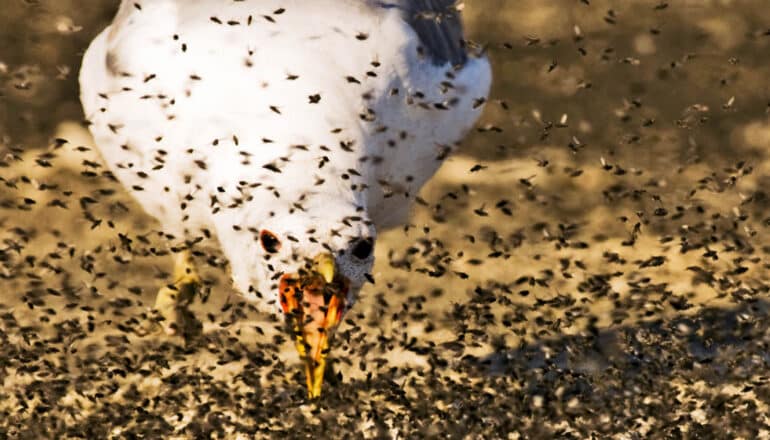
Tiny brine flies are key to conservation of salt lake ecosystems, researchers report.
Brine flies are a key food source for foraging water birds at inland salt lakes including Utah’s iconic body of water, Mono Lake in California, and Abert Lake in Oregon.
In many parts of the world, inland salt lakes are drying out as salt concentrations increase and surface areas shrink—consequences of the protracted diversion of inflowing streams and more recently, drought related to climate change. A study by biologist David Herbst of the University of California, Santa Barbara’s Sierra Nevada Aquatic Research Laboratory (SNARL) in Mammoth Lakes shows that the increasing salinity of salt lakes poses a physiological threat to the quantity and quality of brine flies, their aquatic larvae, and pupae life stages—thereby posing a similar threat to the birds who visit such lakes to feed and breed.
The findings appear in the journal Frontiers in Ecology and Evolution.
“This is really about salt lake conservation,” says Herbst, who conducted most of the research at Mono Lake. “Knowing what the flies need to thrive determines the best habitat conditions for the birds that come to these lakes to feed. Who’d have thought that fly physiology would be useful to knowing the critical water needs to sustain the habitats of these rare and threatened ecosystems?”
Indeed, inland salt lakes are vital ecosystems for foraging water birds. Every year hundreds of thousands of birds, often on long migratory journeys between North and South America, can visit these lakes; having a productive, dependable food source waiting for them is crucial to the viability of many species. Brine flies are essential items on their menu.
Larvae of the alkali fly Cirrula hians are adapted to life in alkaline salt lakes by virtue of the ability to keep their internal body fluids at a constant concentration of solutes (dissolved minerals) even as lake external salt content varies—a process known as osmoregulation. These lakes are often several times as salty as seawater, Herbst explains, but they contain a mixture of minerals such as bicarbonate of soda, sulfate, and chloride. Osmoregulation requires energy to operate the metabolic machinery that rids the fly larvae of excess solutes.
“The research findings show that with rising salinity and osmoregulatory costs, the growth of larvae is curtailed,” Herbst says, “and though development time is prolonged, the mature size of pupae becomes smaller and fewer adult flies emerge from these pupae, and those that do emerge have lowered reproductive success.”
In short, in lakes where salinity is rising, the productivity of brine fly populations is diminishing.
“As expected, reduced amounts of the algae that fly larvae feed on also limits their growth, yet this, too, is likely to occur as salinities rise,” Herbst adds. “Understanding when and where shorebirds visit salt lakes should then be predictably tied to changing salinity levels, and knowing the optimum conditions for alkali fly productivity will be useful in gauging the amount of water needed for restoring and protecting the vitality of salt lake ecosystems.”
Herbst has been researching saline lakes for more than three decades, dating back to his dissertation work at Oregon State University and to his early research at SNARL.
“It is so timely to retrieve this data in light of so much renewed concern,” he says. “Mono has not gained much in water level (since the mid 1990s) and Lake Abert is in even more dire condition, as it has been all but nearly dry in recent years. Both lakes will benefit from the surfeit of snow that will melt this spring and flow into these parched basins, but that may only be a short-lived reprieve. As climate-induced drought contributes to ongoing water shortages, the long-term trends have been down, with salinity rising and streams still diverted to LA or, in the case of Abert, to local agricultural uses.”
Similar trends of desiccation are affecting salty lakes in North America and across the world. Now, with $25 million in funding via recent legislation, Herbst notes, the US Geological Survey will lead studies intended to provide strategies for monitoring the vitality and sustainable management of these lakes.
“This is coming from concerns over human health from dust pollution coming off exposed playas, as well as threats to the hundreds of thousands of shorebirds that use these usually productive lakes as fueling stations,” said Herbst, who is collaborating with other scientists and conservationists at Great Salt Lake to develop monitoring methods and track brine flies. “The flies are significant to this in that they are super-abundant and aggregate in the tens of thousands per square meter of adults onshore or aquatic larvae and pupae in the shallows, making them easy prey and nutritious in the diet—at least when salinity conditions permit.
“What is the cost of the physiology that permits them to thrive in salt water, and what salinity range provides optimum productivity for this insect?” he continues. “There are other brine flies of similar ilk that can be found in other saline lakes and the story remains the same: there is a cost for osmoregulation that will limit fly productivity and, in many cases, these lakes are at or beyond the limits that permit them to be super-abundant and sustaining of waterbirds.”
Source: UC Santa Barbara
The post Brine flies are crucial to salt lake ecosystems appeared first on Futurity.
from Futurity https://ift.tt/i2W1zKH
No comments:
Post a Comment